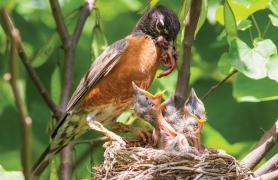Dedicated conservation partners help restore and protect Missouri’s unique micro deserts.
As nature lovers, we Missourians take pride in our state’s mysterious caves, glorious forests, and mighty rivers, but did you know the Show-Me State also treasures a collection of tiny deserts? If you’ve ever seen a roadrunner, scorpion, or tarantula along a Missouri trail, you were probably hiking through a glade.
Bedrock Survival
Glades are small, rocky openings on hills in woodlands and prairies. They form where layers of rock jut through the shallow soil. In Missouri, glades are scattered throughout much of the southern part of the state. Some Missouri plants and animals are strictly adapted to glade habitat and depend on it for survival. In fact, different kinds of glade plants are associated with the five different kinds of bedrock that lie underneath. Igneous, sandstone, and chert glades support plant, lichen, and moss species that prefer acidic substrates, while plant communities on limestone and dolomite glades are more adapted to alkaline soils.
Tough but Sensitive
You could say that glade life thrives on hardship. In the summer growing season, plants and animals face high temperatures, intense solar radiation, and dry conditions. In the spring, winter, and fall, however, they deal with saturated soils. In addition to hot summers and wet winters, wildfires swept through glades during presettlement times, setting back invasive woody plants like eastern red cedar. Today we use prescribed fires to keep the woody plants at bay. In spite of these extreme conditions, drought-adapted wildflowers, warm-season grasses, and a specialized suite of wildlife flourish in Missouri’s glades. Animals strongly associated with glades include the collared lizard, Missouri tarantula, and the small-footed Myotis bat, which sleeps under rocks or tree bark during the day. Many bird species including Bachman’s sparrow, yellow-breasted chat, and painted bunting frequent our micro deserts, too.
But there are five big threats that even tough glade plants and animals can’t survive. The first is overgrazing, which destroys soft-stemmed plants and increases erosion. The second is continual fire suppression. Without periodic fire, thick stands of trees and shrubs (especially red cedar) crowd out glade-loving wildflowers and grasses — along with the wildlife that need them for food, cover, and nesting habitat. Throw in invasive nonnative species like sericea lespedeza and tall fescue that form dense stands, and the area’s natural diversity is further reduced. Add development and poaching of reptiles and other wildlife to these impacts, and you’ve got a natural community in dire need of help.
Fortunately, landowners like Don and Art Kossman are working with their natural resource management agencies to identify, restore, and sustain glades on their land.
The Kossman brothers’ property lies within the St. Francois Knobs Glades and Woodlands Conservation Opportunity Area about an hour southeast of St. Louis. Their large acreage comprises igneous flat-woods, woodland, and glade natural communities. Starting in 2007 and continuing today, the Kossmans have worked with MDC and the Natural Resources Conservation Service (NRCS) to manage and restore their natural communities. “It’s all about diversity,” Don Kossman said during a visit to their land last fall.
“Everything has a place and a purpose,” he said. “Art and I love to come here with our families to hunt, target practice, and watch wildlife. We’ve seen flocks of up to 20 turkeys and bucks with big racks.”
Since 2007, the Kossman brothers have worked with MDC private land conservationists and NRCS’s Lead Resource Conservationist Rob Morrow to implement prescribed burns, remove eastern red cedar, and thin hardwood brush on large sections of woodland and glades.
“For glades, the best thing to do is control the woody encroachment and get fire back on the land,” Morrow said. “We cut the trees to remove the shade and let sunlight down to the ground. When natural glade communities are intact, they bounce right back when you take off the woody pressure. The native grasses and wildflowers were already here, so we didn’t have to plant.”
Glade and woodland restoration on the Kossman property has been made possible in part with financial assistance through the federal Environmental Quality Incentives Program (EQIP), with matching funds from MDC. “Funding through EQIP helped the Kossmans offset the cost to hire contractors to complete the treatments,” Morrow said.
“I cannot emphasize enough how much we appreciate the assistance from NRCS and the Missouri Department of Conservation,” Don said. “The wildlife population, especially turkey, deer, birds, lizards, and rabbits on our property has greatly increased with Rob’s help.”
Do You Have a Glade?
Don and Art Kossman’s igneous glade restoration in St. Francois County is an excellent example of landowners teaming up with conservation agencies to restore and sustain natural communities. If you think your land has an acre or more of natural glade, give your regional office a call. Your county’s private land conservationist can help you determine if you have glade habitat, develop a restoration plan, and find funding to help offset the costs of management. Find regional office phone numbers.
Conserving Glades Wherever They Occur
In Missouri, private and public partners like the Kossmans and Morrow are reintroducing prescribed fire and clearing encroaching trees like eastern red cedar from local glade conservation opportunity areas (COAs). These are places where people can do the most good for glade habitats — and the native plants and animals that depend on them.
Igneous Glades
Igneous describes rocks like rhyolite or granite that formed from lava as much as 1.5 billion years ago. These glades occur on the shoulders and back slopes of knobs and mountain domes. One igneous glade plant of greatest conservation need is Mead’s milkweed, a Missouri state-endangered and federally threatened species.
Private landowners and natural resource management agencies are working to restore igneous glades in the St. Francois Knob Glades and Woodlands COA.
Sandstone Glades
These are associated with open woodland, cliff, and prairie natural communities. Sandstone glades are home to the Missouri state-endangered and federally threatened geocarpon, a kind of wildflower.
Conservation partners, including the Missouri Botanical Garden, MDC, Missouri Master Naturalists, U.S. Army Corps of Engineers, and the U.S. Fish and Wildlife Service (USFWS), are working to conserve Bona Glade Natural Area (NA) located within a sandstone woodland/sandstone cliff complex overlooking Stockton Lake. Woody plant removal and prescribed fire have increased numbers of geocarpon there.
Chert Glades
Rockbound and drought-prone, these globally unique glades have been found only in southwest Missouri and northwest Arkansas, but they may also occur in southeast Kansas and northeast Oklahoma. With only a few scattered acres remaining in this small region, they are Missouri’s most limited type of glade, and are therefore considered imperiled.
At Wildcat Glades Conservation and Audubon Center next to Wildcat Glade NA, the City of Joplin, MDC, and the National Audubon Society are safeguarding 27 acres of chert glades. Other partners include MMN, the Ozark Gateway Audubon Chapter, Master Gardeners, and many local universities, schools, and businesses.
Limestone Glades
These natural areas occur on steep slopes above streams and on gently rolling hills along the west and north borders of the Ozarks. They support wildflowers, grasses, and sedges interspersed with groups of stunted trees. Limestone glades on the Springfield plateau are home to the state-endangered Missouri bladderpod.
Danville Conservation Area (CA) lies within the Missouri River Hills Priority Geography in central Missouri. Conservation partners include the Missouri Bird Conservation Initiative, Missouri Conservation Heritage Foundation, MDC, NRCS, National Wild Turkey Federation, Quail Forever, Quail and Upland Wildlife Federation — Ruffed Grouse Chapter, and USFWS. Restoration efforts have benefited glade species like prairie dandelion, six-lined racerunner, and blue-winged warblers.
Dolomite Glades
These kinds of glades look like prairies with lots of exposed dolomite bedrock, which is a kind of limestone. Where they occur in the southwestern part of the state, they harbor unique wildflowers like the Missouri coneflower and uncommon wildlife like the greater roadrunner and the Texas mouse, both largely restricted to this natural community in Missouri.
The 40,000-acre Angeline CA in the heart of Missouri’s Ozark Mountains features both igneous and dolomite glades. Working with private and nonprofit partners, such as AmeriCorps St. Louis, and using commercial timber sales, area managers have removed red cedar and applied prescribed fire to the area’s glades. Treatments have benefited six-lined racerunners, prairie warblers, and the Ozark-restricted Bush’s skullcap.
The limestone glades of Rocky Barrens Conservation Area in Greene County are home to the state-endangered and federally threatened Missouri bladderpod, a small, showy plant in the mustard family.
A kind of succulent, the beautiful rock pink thrives in the acid soils of the rare chert glades at Wildcat Glade Natural Area. The igneous glade at Knob Lick Towersite in St. Francois County is covered with native grasses like little bluestem and wildflowers like tickseed, pineweed, and sunflowers.
The White River Balds Natural Area in Taney County conserves some of the largest and finest dolomite glades in the Missouri Ozarks. The lichen-covered sandstone glades at Bona Glade Natural Area in Dade County provide habitat for the exquisitely camouflaged lichen grasshopper.
Glades
Missouri’s Glade Types
In Missouri, the most abundant glade habitat is found in the Ozark Highlands eco region of the state. However, a few glades are located in both the Osage Plains and Central Dissected Till Plains eco regions.
- Chert glades are globally unique. They have been found only in southwest Missouri and northwest Arkansas, but they may also occur in southeast Kansas and northeast Oklahoma.
- Dolomite glades in general can be found across most of the Ozark Highlands.
- Igneous glades are limited to southeast Missouri.
- Limestone glades are found along the west and north borders of the Ozarks.
- Sandstone glades in Missouri may be found scattered throughout much of the Ozark Highlands, with more dense concentrations on the west, north, and northeast sides of the Ozarks.
Walk Lightly and Take Nothing but Photos
When you visit Missouri’s public glades, you will be tempted to turn over rocks or pick the beautiful flowers. When you feel the urge to take a souvenir, take a photo instead. It will remind you of the great time you had, and it will help you protect one of our state’s remaining mini deserts.
Learn more about Missouri’s glade natural communities at short.mdc.mo.gov/Z3r.
Visit These Glade Hot Spots
Igneous Glades
Ketcherside Mountain CA in Iron County and Hughes Mountain NA in Washington County have good examples of igneous glades.
Sandstone Glades
Explore the sandstone glades at Graham Cave State Park off I-70 between Columbia and St. Louis.
Chert Glades
Wildcat Glade NA in Joplin’s Wildcat Park is a great place to see a chert glade.
Limestone Glades
In Greene County, visit Rocky Barrens CA or the Springfield Conservation Nature Center. In Kansas City, stop by Burr Oak Woods CA.
Dolomite Glades
Visit Victoria Glade CA in Jefferson County near St. Louis, Ha Ha Tonka State Park near the Lake of the Valley View Glade Natural Area Ozarks, or Henning CA in Branson.
Plants and Animals of Greatest Conservation Need
- Missouri tarantula
- Greater roadrunner
- Painted bunting
- Eastern collared lizard
- Fremont’s leather flower
- Geocarpon
Not every glade in Missouri has been mapped, but many have. To see if you may have glades on your property, visit the Conservation Biology Institute’s interactive map of natural glades in Missouri and Arkansas at short.mdc.mo.gov/Z3y.




















Also In This Issue


And More...
This Issue's Staff
Art Director - Cliff White
Associate Editor - Bonnie Chasteen
Staff Writer - Heather Feeler
Staff Writer - Kristie Hilgedick
Staff Writer - Joe Jerek
Photographer - Noppadol Paothong
Photographer - David Stonner
Designer - Les Fortenberry
Designer - Marci Porter
Designer - Stephanie Thurber
Circulation - Laura Scheuler






















